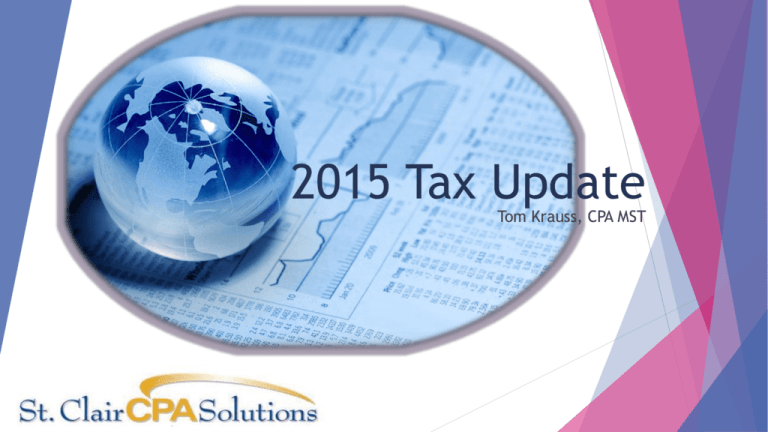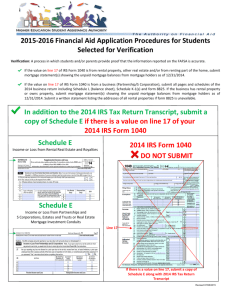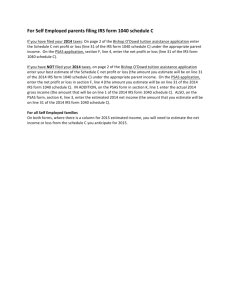2015 Tax Update
advertisement

2015 Tax Update Tom Krauss, CPA MST 2015 Tax Update Topics to be Covered PATH act Extenders NEW Deadlines 2015 NEWS RELEASE NEW ITEMS FOR 2015 form 1040 2015 revenue rulings, notices, & RELEASES What happens if YOU are a FRAUD VICTIM POTENTIAL IRS AUDIT FLAGS and Trends Protecting Americans from Tax Hikes Act of 2015 (PATH act Extenders) For Individuals Permanent Extensions State and Local Sales Tax Deduction American Child Opportunity Tax Credit Tax Credit Earned Income Credit Teacher’s Classroom Expense Deduction Charitable Qualified Distributions from IRA’s Conservation Contributions More Protecting Americans from Tax Hikes Act of 2015 (PATH act Extenders) For Individuals Two- Year Extensions Qualified Tuition/Related Expenses Deduction Mortgage Debt Exclusion Mortgage Insurance Premium Deduction Protecting Americans from Tax Hikes Act of 2015 (PATH act Extenders) For Businesses Permanent Code Extensions Section 179 Expensing Research Tax Credit 100-Percent Reduced Gain Exclusion on Qualified Small Business Stock Recognition Period for S-corporations Built-In Gains Tax More Protecting Americans from Tax Hikes Act of 2015 (PATH act Extenders) For Businesses Five- Year Extensions Bonus Work Depreciation Opportunity Tax Credit Under Code Section 6056, applicable large employers (generally, those with 50 or more full-time employees and equivalents) are required to file with the IRS, and distribute to employees, forms containing detailed information regarding offers of, and enrollment in, health coverage. In most cases, employers and coverage providers will use Forms 1094-B and 1095-B and/or Forms 1094-C and 1095-C. The chart below shows the new deadlines: OLD deadline Deadline to Distribute Forms to Employees and Covered Individuals Deadline to File with the IRS (paper) (electronic) NEW deadline Feb. 1, 2016 March 31, 2016 Feb. 29, 2016 May 31, 2016 March 31, 2016 June 30, 2016 2015 IRC SECTIONS and NEW LAWS 2015 IRC SECTIONS and NEW LAWS On July 31, 2015, H.R. 3236 (P.L. 114-41), the Surface Transportation and Veterans Health Care Choice Improvement Act of 2015 (the “Highway Act”) was signed into law. For tax years beginning after 12/31/15 (beginning with 2016 returns): Form 1065 will be due March 15 & extended due date will be September 15 Form 1120 will be due April 15 & extended due date will be September 15 Form 1120S will remain due March 15 & extended due date will be September 15 Form 1041 will be due April 15 & extended due date will be September 30 Form 1040 will remain due April 15 & extended due date will be October 15 More The HIGHWAY ACT – NEW RETURN DUE DATES & MORE (CONT’d) FINCEN Form 114, Report of Foreign Bank and Financial Accounts, used to be due on June 30 to Treasury. Under the Highway Act, for tax years beginning after 2015, the due date will be April 15 with a six month extension to October 15 allowed. Penalties for failure to file an extension for Form 114 may be waived for first time filers. More The HIGHWAY ACT – NEW RETURN DUE DATES & MORE (CONT’d) Under this act, mortgage interest information Form 1098 will need to report more information. Currently, the name and address of the person from whom the mortgage interest is received, the amount of interest and points received are reported. Under this law, the new information to be reported will be: The outstanding mortgage at the beginning of the calendar year The mortgage origination date The address or description of the property that secures the mortgage IRC SEC 529A – ABLE ACCOUNTS The Achieving a Better Life Experience Act of 2014 was enacted on December 19, 2014, as part of The Tax Increase Prevention Act of 2014. The ABLE act creates new section 529A of the IRS that permits a state to establish and maintain ABLE accounts. An ABLE account can be established for the sole reason of meeting the qualified disability expenses of the designated beneficiary who is a resident of that state. ABLE accounts are intended to work like 529 plans for college savings. The earnings can grow tax free and then be withdrawn to pay for qualified expenses. As of October 2015, at least 34 states have enacted legislation to allow ABLE accounts, none of which were PA, NJ or NY. NEW ITEMS FOR 2015 form 1040 DRAFT 1040 PAGE 1 DRAFT 1040 PAGE 2 NEW ITEMS FOR 2015 Form 1040 Based on the “What’s New” section of the draft Form 1040 instructions posted as of September 15, 2015: For health coverage in 2015, providers are required to provide Form 1095-A, 1095-B or 1095-C by January 31, 2016 to individuals enrolled - the forms will show the months that coverage was provided. The due date for individual returns will be April 18, 2016 due to the Emancipation Day holiday in DC. For residents of Maine and Massachusetts, the due date will be April 19, 2016, because of the Patriots’ Day holiday. More NEW ITEMS FOR 2015 Form 1040 (cont’d) Certain amounts received because of the death of a public safety officer are nontaxable (Publication 525). A special rule applies for cash contributions made between January 1, 2015 and April 15, 2015 to benefit the families of slain NY detectives Wenjian Liu or Rafael Ramos (Publication 526). Refunds can now be directly deposited to a new retirement savings program called myRA accounts (www.myRA.gov). More NEW ITEMS FOR 2015 Form 1040 (cont’d) The health coverage tax credit had expired at the end of 2013, but has been reinstated retroactively to January 1, 2014 (Form 8885). Expires 2019. The additional child tax credit can’t be claimed if Form 2555, Foreign Earned Income, or Form 2555-EZ, Foreign Earned Income Exclusion, are filed (Form 8812). The health care individual responsibility payment increased in 2015 compared to 2014 (Form 8965). For individuals enrolled in Marketplace health insurance, Form 8962 will need to attached to their return to reconcile any advanced payments received with the premium tax credit. The Marketplace is required to send Form 1095-A by January 31, 2016 listing the advance payments and other items to figure the premium tax credit. 2015 NEWS RELEASE NEWS RELEASE IR-2015-26 – DIRTY DOZEN Tax SCAMS 1) Phone scams 2) Phishing 3) Identity Theft 4) Return Preparer Fraud (skimming refund, charging inflated fees) 5) Offshore Tax Avoidance 6) Inflated refund claims (scam using promises of inflated refunds) More NEWS RELEASE IR-2015-26 – DIRTY DOZEN TAX SCAMS (CONT’d) 7) Fake charities 8) Hiding income with fake documents (such as 1099’s) 9) Abusive Tax shelters 10) Falsifying income to claim credits (such as the EITC) 11) Excessive claims for Fuel Tax Credits (fraud can involve a $5K penalty) 12) Frivolous tax arguments NEWS RELEASE IR-2015-54 – IDENTITY THEFT In this news release, the IRS stated it would stop processing suspicious tax returns with indications of identity theft but contained a real taxpayer’s name and/or social. In this situation, the IRS would send the affected taxpayer a Letter 5071C or Notice CP01B requesting that person to verify their identity via the Identification Verification website or by calling the IRS at a toll free number in the letter. Taxpayer has 30 days to respond to the letter or notice. Once identity is confirmed, the return is processed and refund issued in approximately 6 weeks. According to a 3/31/15 TIGTA report, the IRS has expanded the identity theft filter from 114 filters in 2014 to 196 filters in 2015. The IRS confirmed close to 130,000 identity theft returns as fraudulent using these filters. ANNOUNCEMENT 2015-22 – identity theft protection services In early August’s Announcement 2015-22, the IRS stated that it will not assert that the value of free identity protections services from an organization that suffered a data breach is includable in the victim’s gross income. The announcement applies to anyone whose personal information may have been compromised, including customers, employees and others. The amounts paid for identity protection services do not have to be included in Form W-2 or Form 1099-MISC. This relief does not apply to cash payments received as a result of data breach as part of a compensation package. What happens if YOU are a FRAUD VICTIM Steps for Tax Identity Theft Victims • Contact the IRS Identity Protection Specialized Unit at 800-908-4490 (8 a.m. to 8 p.m., local time) • File IRS Identity Theft Affidavit (Form 14039) • Have valid identification (government-issued identification: Social Security card, driver’s license, or passport) • When your case is resolved, you will be issued an Identity Protection PIN • Go to: irs.gov/identitytheft Identity Theft Affidavit Form 14039 The Internal Revenue Service has agreed to change its policy on identity theft and provide victims with copies of the fraudulent tax returns that have been filed under their names by scammers. Steps to Prevent More Harm Contact credit reporting agencies place a fraud alert consider a credit freeze request and review your credit report File a complaint with the FTC at 877-ID-THEFT File a police report Contact the companies where fraud occurred Fraud Alerts 90 days Renewable for 7 years Entitles victim to one free credit report Need to call only one of the three credit reporting agencies; it will notify the others: Equifax: Experian: TransUnion: 800-525-6285 888-397-3742 800-680-7289 Creditors must take “reasonable steps” to verify your identity How to Place an Initial Fraud Alert Contact 1 credit reporting company. Report that you are an identity theft victim. Ask the company to put a fraud alert on your credit file. Confirm that the company you call will contact the other 2 companies. Placing a fraud alert is free. The initial fraud alert stays on your credit report for 90 days. Be sure the credit reporting companies have your current contact information so they can get in touch with you. More How to Place an Initial Fraud Alert (cont’d) Update your files. The credit reporting company will explain that you can get a free credit report, and other rights you have. Mark your calendar. The initial fraud alert stays on your report for 90 days. You can renew it after 90 days. Update your files. Record the dates you made calls or sent letters. Keep copies of letters in your files. POTENTIAL IRS AUDIT FLAGS and Trends POTENTIAL IRS AUDIT FLAGS FOR INDIVIDUAL RETURNS 1. The higher the income, the greater the odds of being selected for audit. For 2014: o $200,000 or higher – 2.71% audit rate or 1 out of every 37 returns o $1 million of higher – 1 in 13 chances o Less than $200,000 - .78% audit rate and mostly correspondence audits 2. A mismatch of income reported creates automated underreporting notices 3. Higher than average deductions – be sure to have the documentation available 4. Large charitable deductions compared to the average at that individual’s income level – have supporting documents available 5. Schedule C – especially cash businesses and Schedule C’s with large losses 6. Rental losses deducted by real estate professions – documentation of hours spent is important to have in files More POTENTIAL IRS AUDIT FLAGS FOR INDIVIDUAL RETURNS(cont’d) 7. Alimony deductions – a mismatch with the ex-spouse’s reporting can create IRS inquiry 8. Hobby losses on Schedule C – the IRS looks for losses year after year 9. Large amounts of meals and entertainment – applies whether Sch A (employees) or Sch C (business owner) is used 10. Claiming 100% business use of autos 11. Claiming day-trading losses as a trader on schedule C 12. Failure to report gambling winnings or claiming gambling losses in excess of gambling winnings 13. Claiming home office deduction 14. Failure to report foreign bank account(s) Trends 1. Meaningful tax reform is probably years off because of timing of the election and the philosophies of the parties. 2. IRS audits are down: 2014 rate was 0.86% vs 2013 (0.96%). 2011 was 1.11% 3. 4,300 Criminal investigations began in 2014; 20% less than 2013. 4. In the 2015 filing season, 60% of taxpayers were unable to get through. Wait times on the Tax Practitioners’ Hotline (866-860-4259) were often over 60 min. 5. According to TIGTA, IRS is not catching filings of Form 8283 (noncash donation) that do not have the required substantiation. Trends 6. TIGTA estimated billions in erroneously claimed education credits. 7. IRS says they have collection over $7 billion in taxes from offshore VDAs. (Voluntary Disclosures) 8. Definition of “marginal tax rate” is affected by: • Phase-out of itemized deductions: 1.19% • Loss of personal exemptions: 1.29% per exemption • Net investment income tax: 18.8% or 23.8% depending on AGI • AMT phase-out costs another 1.5% or more QUESTIONS?



